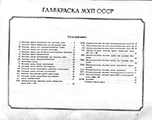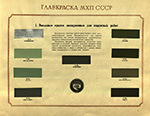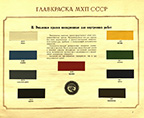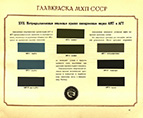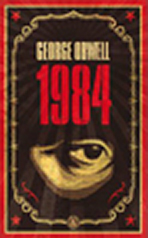 |
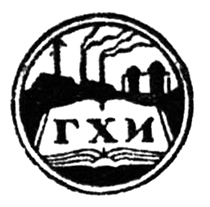 |
GOSKHIMIZDAT's 1948 Catalogue Examined
Perhaps research into VVS camouflage and colouration, too, has been seen to be "uncomfortable" to many. Not only the colouration itself, mind, but the source of such work is an intolerable "threat" to Right-wing extremists, nationalists and other fellow-travellers in Russia. 'How dare a foreigner write about our history'!? 'Surely, this must be criminal and cannot be correct, regardless of the content'! While such sentiment must seem ludicrous-- because it is ludicrous-- it is also woefully common. And to be put into motion, such idiocy requires a catalyst; and thereby is explained the sudden importance, seventy years after its publication, of a booklet issued by GOSKHIMIZDAT. Surely, this holy script must vanquish the evil one and his poisonous lies?
I regard this matter, moreover, to be a product of the dysfunction of modern society. In the new "Wikipedia World", where truth and fact are decided by popularity, it might seem perfectly normal to brandish such a red-booklet in the face of tedious and conspiratorial 'anachronisms' such as archaeology, photographic evidence and chemistry, and to embrace the New And More Comfortable Truth. The breakdown in the popular understanding of what constitutes evidence, let alone theory and fact, is virtually total. I despair unreservedly at the observation that a few jpg scans from Russian file-sharing sites and their promulgators have been accepted in places across the WWW to have disproved twenty-five years of dedicated scientific work! That sentence requires reading for a second time, and even then it is scarcely believable! And thereby, once more, it is seen that my work must be defended against... in fact, absolutely nothing.
1948 Al'bom Nakrasok
What is this 1948 work issued by GOSKHIMIZDAT (Ministry for Chemical Industry)? The booklet is a collection of paint chip samples which are accompanied by technical data relating to the suggested use and application of such paints. The technical information in the booklet is impressive, actually. This contains various temperature data, mixing, solvents, and other physical data relating to the paints and their application. Very fine stuff, to be sure.
There is, sadly, not much in the booklet by way of explanation as to why it was completed, save for the following introduction (kindly translated by Ilya Grinberg):
|
"Release of this album allows a wide circle of consumers of lacquers and paints to familiarize themselves with main assortment of such materials produced by factories of Glavkraska (Chief Directorate of Lacquers and Paints) of the Ministry of Chemical Industry. For convenience assortment of lacquers and paints production is given in systematized order in the form of separate groups of materials based on their application. Overall 28 groups are presented, which cover about 300 different types of lacquers and paint materials. In addition to samples of paints (paint chips), characteristics and basic physical and painting properties of materials as well as general recommendations for their usage, are presented. The album with samples allows a consumer to properly use the assortment produced by the factories of Glavkraska and will simplify navigation in selecting materials relevant to items to be painted and specific conditions of particular factories (this means the factories who will use paints, not the factories who produce paint)." |
Well, of course we do not know. However, logical conjecture seems to be pretty straightforward. We know from other records (see the M-Hobby series on VVS colouration, for example) that many older lacquers went out of manufacture in 1948. It seems perfectly reasonable to assume that, following the chaos of the wartime manufacturing situation, the government would wish to reorganise and and better standardise the production of various paints and lacquers. Older types disappeared and likely some new types were introduced in this effort. In such a case, the desire-- in fact, the need-- to issue exactly such a booklet is self-evident.
Moreover, it should be borne in mind that this booklet covers the work of the entire paints and lacquer industry of the USSR. It is hardly, as has been prepostereously suggested elsewhere, some kind of specific record of the lacquers of the aviation industry! It has even been seen in one case that a Russian poster claimed this was an historical record of VVS lacquers! The mind reels at such stupidity. An examination of the table of contents reveals the bredth of the various families of paints and their respective employment within the industry (automotive, aviation, industrial, etc.).
The phrase "main assortment" in the introduction is notable. One presumes that this explains why the 1948 Al'bom Nakrasok is not comprehensive. We can state without any question whatever that this book is not a complete record. For example, the singularly most utilised aviation lacquers of 1948-- by specific government instruction, and confirmed by the photographic record-- were AMT-16 Grey and its all-metal counterpart, A-36m. Neither lacquer appears anywhere in this book. Moreover, this is so only in relation to aviation lacquers; no doubt when examined by experts of other fields within Soviet industry that such omissions would be identified as well. Of course, covering as it does the entire paint manufacturing programme of the nation, it is hardly surprising that the catalogue is not comprehensive; such a work would likely have been next to impossible in scope. And one might ask why were these two ubiquitous lacquers were omitted? We again do not know; perhaps they were 'too common' and not especially useful to bring to the attention of would-be customers?
The Paint Chips
So much for what the book does not contain; what paint examples are, in fact, in it? The 1948 booklet describes four main families of aviation-related lacquers. Nine examples of the older A- series of primers (which are not specific to aviation, but used therein) are included. These may be unmodified from their earlier, wartime appearance (so far as can be determined; see below), and contain one apparent correction to my own work [I had mistaken the nomenclature of "A-11" as a Roman Numeral "2", thus 'A-2 White'; it would seem that 'A-11 (eleven) White' is correct in fact]. Six examples are provided of AMT lacquer [AMT-1, 4, -6, -7, -11, -12] along with two corresponding versions called "AGT" (AGT-4, -7) for green and blue. Six Am series lacquers are also found [A-21m, -24m, -26m, -28m, -32m, -33m], and once more these are grouped with two additional lacquers called "Ag" [A-24g and A-28g] again for green and blue. And, there is one more verious curious addition to this grouping-- a chip called "AEh-8 Aluminevaya" [it is the only AEh lacquer in the entire booklet, and what is it doing with the Am finishes?]. Lastly, there are three examples of the AII lacquer family in the 1948 booklet [AII Aluminium, White, Red].
Of the physical paint chips, themselves, what can be described? Two copies of this book were examined (a third example is known, but not yet seen) in the preparation of this article. The best preserved example was that found in the NLR collection in Moscow, and the scans herein are from that source. The most obvious factor regarding these samples is their severe deterioration, depending more or less on the state of preservation. The paper on which the book was printed is the very typical highly acidic variety so thoroughly ubiquitous in Soviet publication. The majority of these pages are now yellow or even orange (in one case brown!) due to oxidation and contamination. The chips sitting on them are similarly degraded, and as a result of this severe oxidation are considerably darker now than they ever would have been when new, and have shifted in hue additionally. Indeed, looking to other physical evidence it is clear that the paint chips on these pages have oxidised more than a typical sample located on an archaeological artefact (e.g. old aircraft wreckage), which is perfectly logical when one notes that the paper absorbs and concentrates contaminants from the environment. As well, given the different states of preservation, the sampes of the same paint in each volume do not match each other.
As a result, it is simply not possible to guess what the authentic appearance may have been of any chip in the entire booklet in 1948. Full stop. There is no way around this problem. To accept the appearance of these specimens in their current form as literal representations of the 1948 appearance is morosely incompetent; to attempt to claim further that these decrepit, rusting bits of lacquer are proof (understanding the weight of that term) of anything is shockingly stupid. Moreover, to chemically analyse these samples would require their destruction, which is of course not possible; we shall likely never know anything substantial about them.
The AMT lacquer samples. It can be seen that all of them are extremely dark, virtually black.

The 1948 booklet's chips showing those of the same nomenclature of the common wartime AMT lacquers.
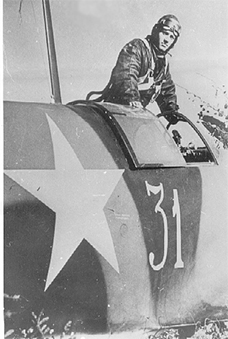
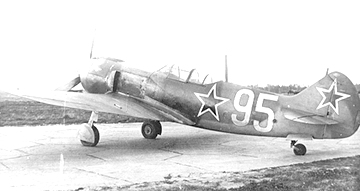
Examples of AMT colouration from the war on b/w film. (left) The fuselage of a LaGG-3 showing the identical location to our museum sample below, and finished in the same lacquers AMT-4/-6/-7. (right) Typical AMT-11/-12/-7 NKAP style camouflage on an La-5FN.
To suggest that the booklet's chip colours as they are could explain the tonal character of AMT lacquers on period b/w images defies all belief. One wonders if it is even possible to actually be so incompetent regarding photography, or if such claims are simply the desperate and illogical ramblings of hate propaganda?
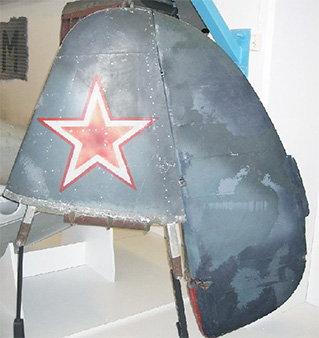
The fin and rudder from a Yak-9 (unknown model). Despite being somewhat decrepit, the finish is surely the original AMT-11/-12, soiled and darkened in places variously due to its non-particularly-well preserved state.
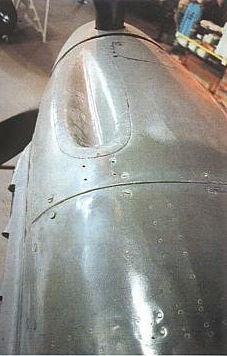
The Krakow Museum's Yak-3 as it appeared in 1992. At that time, the sole modification to its original AMT-11/-12/-7 paint was the application of a coat of clear lacquer to protect the surfaces. In this researcher's view, this example is (or was) the most authentic appearance of AMT-11 and -12 from the GPW period left to us.
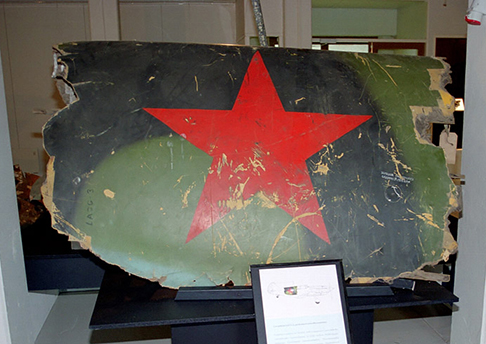
A preserved section of fuselage from a LaGG-3 in a Finnish collection. AMT-4/-6/-7 colouration is evident here. The colours are slightly desaturated (obviously, being rather old and variously preserved), but still fundamentally resemble their original appearance. The national star, by the way, is indeed painted with A-13 Red.
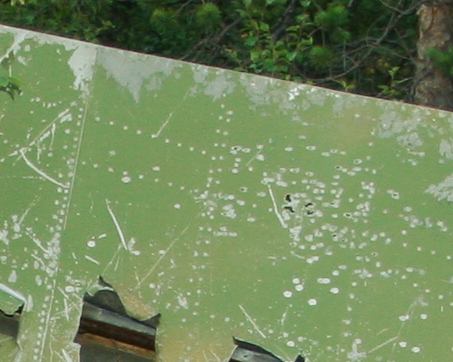
The outer section of a metal winged Il-2 'arrow' which was painted with the 3-colour NKAP scheme, found in a forest near the Russian/Finnish border.
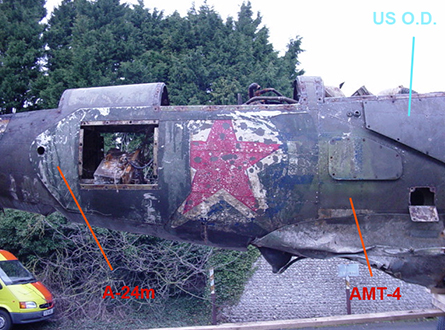
P-39 "White 23" (s/n 442911) at the time of recovery. Three green colours are seen, as marked. The areas of A-24m were applied to reinforcement plates added as per an order dating from 1944. This aircraft is now under the observation of Ilya Grinberg in New York.
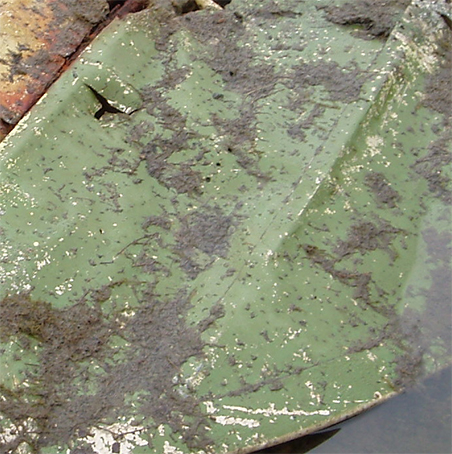
The starboard fin of Pe-2 p/n 141-16 from the collection at Bodo, Norway. Interestingly, the aircraft was originally finished in AII lacquers over ALG-1 primer, which can all still be found on the airframe. However, repair work was carried out at some point on the starboard side of the aircraft. These affected areas were painted with AMT-4 (for example, the starboard elevator fabric shows AMT-4 applied comprehensively over AII Black). The starboard fin shows only AMT-4 colouration (no repainting is evident, and indeed no primer can be seen), and is thought to be a replacement unit.
Concentrating on AMT-4 for a moment, one cannot see the same colours on each individual monitor, of course-- this problem has been discussed to death. However, I believe that one should be able to see that these colours do compare to each other; that they are the same paint, and further they all agree with the wartime photography in tonal contrast. If one were to inspect them in person, one would be certain that they are the same lacquer. Physical inspection is the only standard of examination which I will accept, and it is the minimal effort required to contribute to this discussion. Research on this topic is not performed sitting anonymously behind one's keyboard, typing out ludicrous accusations and claims.
Specific Colour Questions
Some matters of contention, and possible discoveries, and significant mysteries, are seen in the 1948 booklet, however. A more in-depth examination is required in several cases.
The first of these conundrums involves the appearance of aviation lacquer AEh-8. It is at once a curiosity that the only lacquer of this family in the booklet is this one. Did all other AEh lacquers go out of use, or were they simply not mentioned? Why is this paint listed with the Am/Ag lacquers? We may never know.
In his superlative work on the SB, researcher Mikhail Maslov has described the lacquer AEh-8 as 'silver-grey'. He does not, alas, define its official nomenclature at that time. In 1948, the official nomenclature was "aluminium", which is highly incongruous if we look to the historical record of this finish. Indeed, the appearance of AEh-8 in this booklet is extremely similar to that of AII Aluminium. Assuming that this was really the case in 1948 (resulting from the deterioration problem), how can that be explained?
In brief, it cannot. Maslov and others have published many close-up photographs of SBs wearing finish AEh-8. In none of these do we see anything remotely like the kind of surface reflectivity and the 'granularity' of the finish that would be expected of a paint like AII Aluminium (which, by the way, exhibits both of these features in such photographs). More importantly, no physical examples exist which we know are AEh-8 which have any kind of 'silver' appearance. Every such sample is a grey colour as I have described in SAFFC. These are all from SBs; they are without doubt AEh-8 lacquer.
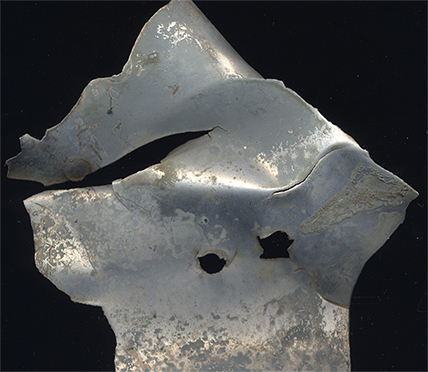
A section of the undersurfaces of Republican SB BK-093. In this location AEh-8 has been applied directly over the dural surfaces, as explained by Maslov regarding the finish of the early SB's fuselage. Note the complete lack of 'granularity' in the paint, and the grey colour.
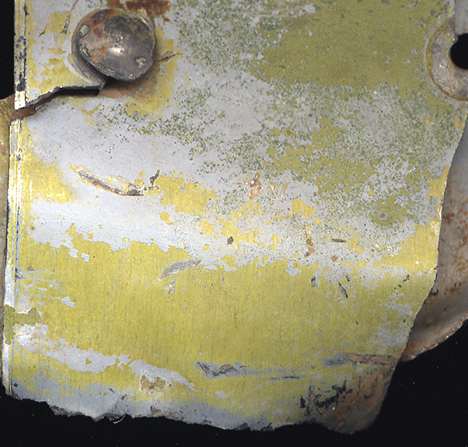
A piece of the wing joint strap from BK-093, we believe near to the wing leading edge. In this location ALG-1 primer has been applied, and over that AEh-8 comprehensively. In the upper portion some Spanish olive green colour may be seen.
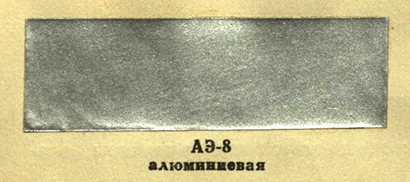
The 1948 booklet's chip for "AEh-8 Aluminium".
If one speculates upon (and that would be speculation, to be sure) a new appearance of the colour as shown on the physical remains, then such would be in agreement with the photographic record of such paint as published. Is it possible that this paint has deteriorated to hide the 'silver' appearance? Well, possible-- yes; but likely, no not at all. How could one explain that all the samples deteriorated to same 'incorrect' appearance? Hugely unlikely, to say the least. Most of all, I cannot see how anyone, regardless of any levels of deterioration, could compare these two samples of paint (AEh-8 from a 1936 SB and from the 1948 booklet) and determine that they are the same finish. This is surely impossible.
Another considerable mystery involves the appearance of the chip in this booklet for A-28m. It is true that the chips in fact have the appearance of light to medium green in the various books; this resulting from their poor condition (yellowing due to oxidation and contamination). I suspect that, when new, these might have been some kind of light blue colour.
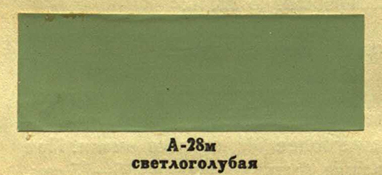
A-28m Light Blue as it appears in the booklet.
Light blue? This makes no sense, surely? All Am lacquers are characterised by their dark appearance, this imparted at least to some degree by the carrier (the actual unpigmented lacquer) which is a 'light-ish' muddy brown colour. If then one were to mix the pigments used for AMT lacqures into this carrier (which I have always assumed was done), the result would in fact be precisely the appaerance of Am as described in SAFFC. But, this procedure cannot explain the A-28m chip in the 1948 booklet, no matter what the original appearance. It is possible that in 1948 this chip would have looked something like the wartime appearance of AMT-7 Blue, which is very strange indeed. Moreover, the chips in the 1948 booklet for AMT-7 (and AGT) bear a striking resemblance to what I believe was the wartime appearance of A-28m.
We have two good colour photos of Il-10s which were built prior to 1948. One was captured in Korea, and the shot taken on good quality Kodak film. The second is on display in the Ukraine (I believe in Kiev). The finishes which were supposed to have been used to paint these two were to have been A-24m and A-28m. Both images show colours which agree with each other; both look like A-24m and A-28m as described in SAFFC.
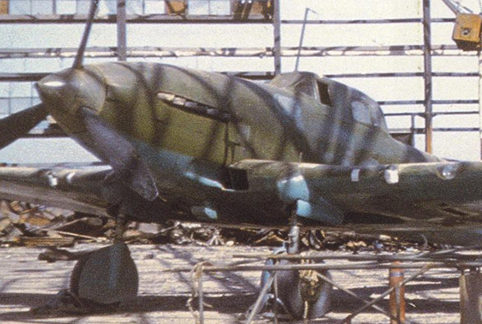
Kodachrome photograph of a captured Il-10 in Korea.
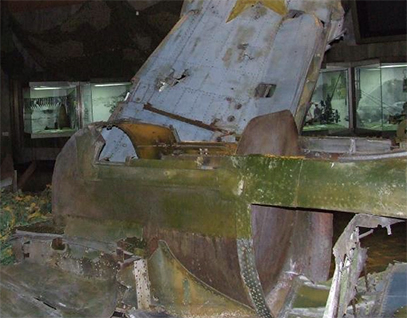
Wreckage of an Il-10 in an Ukrainian museum. My apologies for the poor lighting in this shot.
However, it seems clear that neither of these examples agree with the 1948 chip for A-28m, at the minimum (the booklet chips for A-24m are impossible to understand). They might agree with the booklet chips for AMT-7 or AGT-7, perhaps, so one is left to wonder if the Il-10s were painted with those lacquers? But, if that is so, how can it be that the appearance of the booklet AMT-7 chip is in utter disagreement with wartime examples of AMT-7? A considerable mystery. Is it possible, I wonder myself, that the chips for AMT/AGT-7 and A-28m/g were accidentally switched? One could see how easy this would be for anyone preparing the booklet. Speculation, of course, but a possibility.
The other fundamental problem is that there just do not seem to be any photographs of VVS aircraft after 1948 showing the colour demonstrated in this book for A-28m, neither are there any surviving samples of such a colour (save perhaps for the late appearance of the Monino Tu-2; but that is a topic for another day). If this chip does show anything like the actual appearance of A-28m after 1948, then we can state with authority that such finish was rarely, if ever, in fact used.
A Working Theory-- What Does It All Mean?
The 1948 Al'bom Nakrasok, at its absolute best, is a corroded example of some of the aviation lacquers as they appeared in 1948. Its significance extends nowhere past this limited point. Its relevance to the appearance of any lacquer-- even those bearing the same apparent nomenclature-- of the Great Patriotic War period or before is demonstrably limited, even non-existent. It is scientifically indisputable that when the documentary evidence does not agree with the physical, archaeological evidence, that the documentary evidence is incorrect; either as such, or incorrectly interpreted (or a combination thereof). There is nothing else to say on this point. That this booklet is held up as criticsm of the data in SAFFC-- let alone as "proof" of its error!-- it so utterly pathetic that I cannot assign any proper adjective to it.
Despite the problems of deterioration, what can we learn from the 1948 chips? The answer to this question relies in many cases on our interpretation of the data in the booklet. The A- series primers do, indeed, seem to be unchanged from their earlier appearance. I would not be overly concerned if anyone were to insist that the original appearance of these chips (however one determines that?) is the authentic appearance of GPW-era A- primers of the same type. Fair enough. The chip for AII Aluminum is also quite simlilar to the samples in my own collection; it was probably unchanged.
IF one wishes to be pedantic, and accept the chips in the booklet unreservedly [and why do so? is this booklet some kind of absurd religious text? when is any document in proper research regarded in this way?], then the best explanation, so far as I can see, is that some paints and lacquers during the 1948 reorganisations (of whatever form they might have been) were modified.
Such a theory is not hard to justify as being eminently reasonable. The government, usually through the auspices of the NKAP, struggled repeatedly during the 1943-45 period to rationalise Soviet aviation painting and camouflage. This was done by introducing new lacquers and promoting their use, even to the extent of offering suggestions on camouflage application to an industry which was patently expert at this skill already. Indeed, so far did the NKAP pursue this idea that in late 1944 it even suggested that bomber camouflage should be discarded altogether, and such machines painted as with fighter aircraft in the same patterns and colours. That suggestion was rejected, but it shows the intentions of the government, nevertheless. Likewise, one can imagine that the Army chaffed considerably at the lack of uniformity shown in wartime colouration. Military thinking being what it is, all armies strive towards regularity and conformity, especially in matters of painting and appearance. The individuality ("chaos" one presumes it would be called) which was manifestly evident in wartime colouration must have been galling. And, indeed, after the war the photographic record is transformed entirely-- gone are the colourful wartime examples, in view are dour single and two-colour applications of surpassing tedium. Military order was restored.
In this light, the idea to revise the pigmentation of any surviving lacquers to have a similar appearance is easily understood. It may be so, should any understanding of the 1948 chips ever be possible, that a uniform and dark appearance of AMT-4 (for example) in 1948 was the result of a deliberate effort to pigment this finish so that it looked very much like-- or identical to-- A-24m. In military thinking this would be quite logical-- repairs or changes could be made and the finish would still be uniform. AEh-8, similarly, might have been re-pigmented to resemble AII Aluminium; and so on. The only real incongruity in this theory would be the appearance of A-28m, which is simply a mystery. If this chip suggests (as best it can, given its state) the authentic appearance, it was presumably not fancied and rarely employed.
On the other hand, IF one takes a more sceptical (or realistic; one may decide which is appropriate here) view of the booklet as a catalogue representing a vast array of paint products from across the industries, and that even in this modern computerised age that no such work is free from the odd error, then another understanding of the work emerges. In this case the chips present in the booklet are helpful, but only to the extent that we can estimate what they looked like originally, and thereafter to the extent that they agree with physical evidence. When they do not, one is left either to interpret the chips as being incorrect (the result of an error in the booklet), or as having been modified (as above). In this view, the suggestion that perhaps the chips for the blue colours in the AMT/AGT and Am/g series were mistakenly placed in the booklet leads to an interesting possibility of some qualification. In this case it may be so that the 1948 chips could be interpreted to not be fundamentally in disagreement to the wartime appearance of these lacquers, but that such an appearance in all probability cannot ever be demonstrated by these chips given their terrible state of preservation.
Is there any hope to put forward an estimation on how badly the chips in the 1948 booklet have darkened and/or yellowed? I have given this matter much thought; I have reached no conclusion. However, allow me to illustrate the problem using two primers which were widely used for many years, ALG-1 and ALG-5. One might assume (and that is all it would be) that these two primers would not have been modified in 1948 in pigmentation. After all, what purpose would this possibly serve; these are primers, not to be seen on any surface (and is it not apparently so that the A- primers were also not modified)?
The freshest and best preserved surviving example of ALG-1 known to me is located on this Pe-2 wing (in storage at Bodo, Norway). The appearance when new would have been lighter still (it does curiously resemble French Dijon mustard to an unnatural degree), of course, as this example is seventy years old, and not even taking into consideration its exposure to the elements and UV radiation.
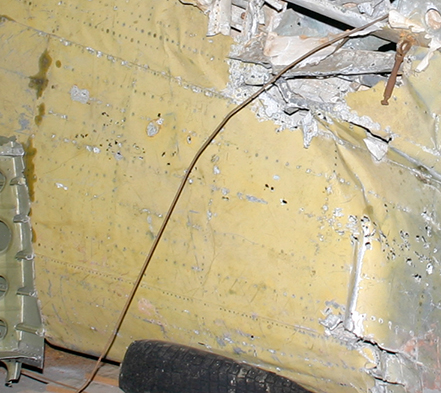
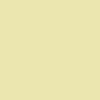
A section of Pe-2 wing surface at Bodo, here showing an unusually well preserved area of ALG-1 primer. To right, my own interpretation of the colour of ALG-1 when new.
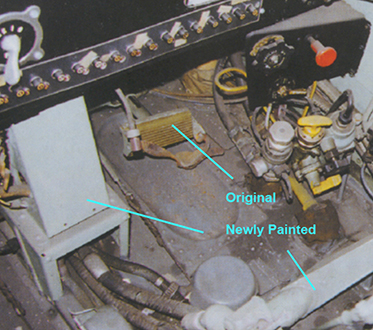
The Kbely Il-10 as it appeared in 1999. To right, my own interpretation of the colour of ALG-5 when new.
The interior of the Il-10 at Kbely has been carefully painted to resemble ALG-5 primer, and indeed this was done with such skill that the original areas of the finish are hard to locate! However, the rudder pedals did (at least in 1999) show authentic examples of ALG-5 primer. Again, this would have been slightly lighter when new, in fact quite like the current finish in the exhibit.
Now, compare these authentic examples of ALG to the chips in the 1948 book... [NB: ALG-1 is top, ALG-5 bottom; the red primer between is described as gliftalevaya No.138]
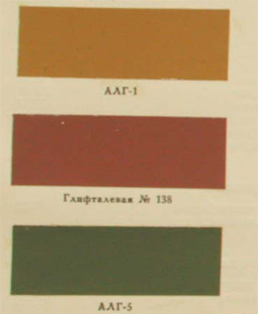
...Horrifically oxidised. There is no other useful phrase to describe how badly these 1948 chips have deteriorated.
By contrast, here are some intermediate stages of ALG-1's deterioration on actual aircraft specimens.
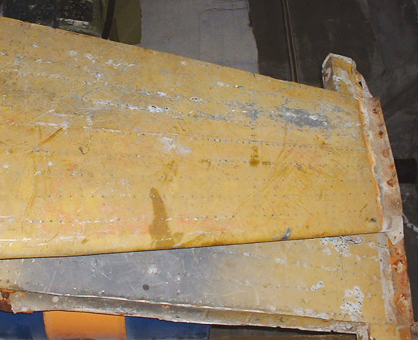
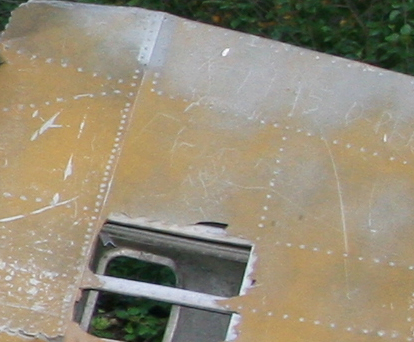
(left) Pe-2 stabiliser at Bodo. This 'golden' tint is very typical of oxidised ALG-1. (right) The most corroded example of ALG-1 I have ever seen on an actual part (this found on an Il-2 wing which has sat uncovered in a forest for 70 years) which is starting to turn orange; it is still, however, less corroded than the 1948 booklet chip.
If one were to de-oxidise this booklet ALG-1 sample, for example, to a degree to match the appearance of the authentic ALG-1 primer, would this same modification applied to the ALG-5 1948 chip result in the correct appearance as well? It's a good question. We know from many, many samples of ALG-1 that it will darken to this kind of yellow-gold colour under considerable atmospheric and UV exposure. This kind of darkening is similar to the effect that one would expect on a sample subjected to a local chemical based type of oxidation attack (i.e. sitting on acidic paper); that is to say, it agrees with the damage to the 1948 book sample, albeit the booklet chip is very badly corroded. Does this evidence, then, convince one that a "reversal" of the oxidation to the ALG-5 sample can be estimated? If this is possible, what about to all of the 1948 booklet chips? In any event, the relative amount that these chips have darkened may serve as a warning to the folly of accepting the other chips as they are now!
Alas, I do not have the answer to this problem at the present time. Perhaps in future more work can be done on this interesting point.
Personal Observations
I hope the foregoing will put an end to the idiocy and personal defamation which have cropped up over this 1948 booklet fiasco. This subject (for reasons unknown to me) has been-- and continue to be-- plagued by an exceptional number of self-promoted luminaries on the topic whose actual incompetence and pettiness simply stagger belief. To fail to understand this booklet, then to use this dubious source as an attack against proper work, is absolutely typical of such persons. However, their guilt is shared, I must point out, by those persons on the internet who have accommodated and accepted these moronic diatribes, quite amazingly without any apparent thought as to their relative merits. And to think, furthermore, that "research" in this field is completed whilst sitting on one's back-side merely adds to the gall. Work is required-- hard work-- and such things are clearly unpalatable to this type of poltroon.
I also hope that the inclusion here of colour photographs of extant specimens will help to clarify the various points, and not to confuse them further. I am aware via copious complaints that the decision not to include such colour photos in SAFFC was a major error. This situation will be rectified in an upcoming follow-on work to SAFFC, which has not yet been titled. However, I would like to explain that this decision was based on the many problems of transmitting the correct appearance of colours on printed pages, or digitally; in neither case is this possible. My fear was that such printed material in the book would have led to chaos as the various appearances of the colours as printed would vary enormously, and thereby result in unending argument. Perhaps now it is so that there is the general understanding by most that digital images of, or printed versions of, specifc colours are not reliable, and so this will not be so serious a problem as I have feared.
One could also here highlight the problems of replicating small, physical bits of paint into digital format. I was asked years ago to scan some of my larger bits of lacquer AII Brown for review by a colleague. The result of that attempt was the hideous image below. Not only is it blurry and unhelpful, but I can state categorically that the appearance of these samples as scanned does not match their actual appearance as sitting next to me, even on my own highly calibrated monitor! The attempt was a failure.
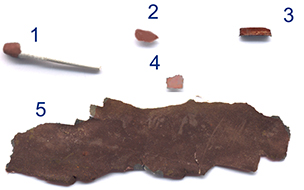
The result of imaging the pieces on my HP scanner.
The long-term solution to this problem is to have actual paint samples prepared by a professional company of standing in the field, with expertise in the analysis and replication of such lacquers. That task is under way right now.
In the meantime, may we please return our attention to proper evidence (such as archaeological finds, wreckage, and the like)? Should any new discoveries arise from such a source, I am-- as always-- the first to enthusiastically examine the data and incorporate it as needed into any work of my own. But, as for these tedious papers and the buffoonish misinterpretation of them... well....
